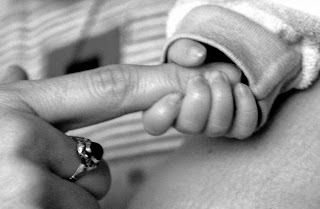Child-bearing beyond age 50
 |
| Photo credit: Newborn holding mom's finger, by MVictoron |
a concern?.
OBJECTIVE: To study maternal and perinatal outcomes in healthy women aged 50 years and older.
METHOD: This study was of 59 clinical pregnancies, of which 10 ended in first trimester spontaneous miscarriage (and were excluded from further studies) and 58 live births. This retrospective review of 58 live births in 49 essentially healthy women (mean [SE] age, [52+/-2.5] years; range 50-55 years), with no chronic medical conditions (of which 28 were primigravids). Pregnancy outcomes were ascertained by chart review and telephone follow-up.
RESULTS: Of the 58 live births, 41 were singletons, and 7 were twins, and 1 triplet, for which the mean+/-SE gestational age at delivery were 38.1 weeks +/-0.4, 36.2 weeks +/-0.1 and 34.1 weeks respectively. Birth weights (mean +/- SE) were 3,201 g+/-10, 2,252 g+/-4 and 1,998+/-95 g respectively. Mean Apgar score +/- SE at 1 and 5 min were 9.2+/-0.8 and 8.8+/-0.6 respectively.
Total cesarean deliveries were 73% (36/49). Of singletons, 68% (28) were delivered by cesarean section as were all multiples. The incidence of pre-eclampsia was 30.6%: mild pre-eclampsia 20.4% (10/49), severe pre-eclampsia 10.2% (5/49). Gestational diabetes required insulin in all 19.5% of women. Anemia was noted in 6.5%.
CONCLUSIONS: Appropriately screened women, aged 50 years or older, can deliver successfully. During pregnancy, they appear to be at increased risk of pre-eclampsia and gestational diabetes. A significant majority can expect to deliver via cesarean.
PMID: 14716494 [PubMed - indexed for MEDLINE]
TODAY'S BOOK SUGGESTION:
 Infertility Survival Handbook
Infertility Survival Handbookby Elizabeth Swire-Falker
-- After seven years of tests and more tests, treatments and more treatments, Elizabeth Swire-Falker understands what it means to struggle with infertility.
In this frank, reassuring, and thoroughly researched handbook, she shares her own personal experience and offers insight into what challenges to expect along the way-from getting support to finding the right doctor to dealing with insurance.
She gave up her career in the process when she found she couldn't struggle with infertility and maintain a high-powered job at the same time.
The years were filled with injections and blood tests and hormones and in vitro fertilization, implantations, and miscarriages, and return trips to the assisted reproductive technology lab.
Click to order/for more info: Infertility Survival Handbook
Don't have a Kindle? Get your Kindle here, or download a FREE Kindle Reading App.










0 comments